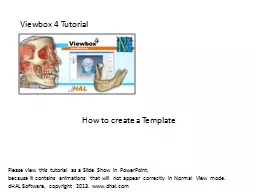PPT-Viewbox
Author : phoebe-click | Published Date : 2015-11-16
4 Tutorial How to create a Template Please view this tutorial as a Slide Show in PowerPoint because it contains animations that will not appear correctly in Normal
Presentation Embed Code
Download Presentation
Download Presentation The PPT/PDF document "Viewbox" is the property of its rightful owner. Permission is granted to download and print the materials on this website for personal, non-commercial use only, and to display it on your personal computer provided you do not modify the materials and that you retain all copyright notices contained in the materials. By downloading content from our website, you accept the terms of this agreement.
Viewbox: Transcript
4 Tutorial How to create a Template Please view this tutorial as a Slide Show in PowerPoint because it contains animations that will not appear correctly in Normal View mode dHAL Software copyright 2013 wwwdhalcom.
Download Document
Here is the link to download the presentation.
"Viewbox"The content belongs to its owner. You may download and print it for personal use, without modification, and keep all copyright notices. By downloading, you agree to these terms.
Related Documents

